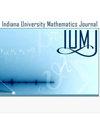考虑井-储相互作用的可压缩气-液模型的松弛极限
IF 1.2
2区 数学
Q1 MATHEMATICS
引用次数: 1
摘要
本文研究了在压力很大程度上取决于周围储层压力的极端情况下,油井中气涌流动的运动。在形式上,该模型可以通过取具有压力相关的井-储相互作用项的两相可压缩气-液模型的松弛极限得到。在初始数据较小的假设条件下,利用能量法研究了模型强解的全局存在性和唯一性。此外,还研究了该解的大时态。我们的结果推广了[18]S. Solem和S. Evje, Z. Angew的结果。数学。理论物理。, 68(2017),第23条]。本文章由计算机程序翻译,如有差异,请以英文原文为准。
The relaxation limit of a compressible gas-liquid model with well-reservoir interaction
In this paper, we are concerned with the motion of gas-kick flow in oil wells for the extreme case that the pressure is largely dictated by the surrounding reservoir pressure. Formally, the model can be obtained by taking the relaxation limit of a two-phase compressible gas-liquid model with a pressure-dependent well-reservoir interaction term. Under suitable smallness assumptions upon the initial data, the global existence as well as the uniqueness of strong solutions to the model is investigated by using the energy method. Besides, the large-time behavior of the solution is also studied. Our results generalize the ones in [18, S. Solem and S. Evje, Z. Angew. Math. Phys., 68 (2017), pp. Art. 23].
求助全文
通过发布文献求助,成功后即可免费获取论文全文。
去求助
来源期刊
CiteScore
2.10
自引率
0.00%
发文量
52
审稿时长
4.5 months
期刊介绍:
Information not localized

 求助内容:
求助内容: 应助结果提醒方式:
应助结果提醒方式:


